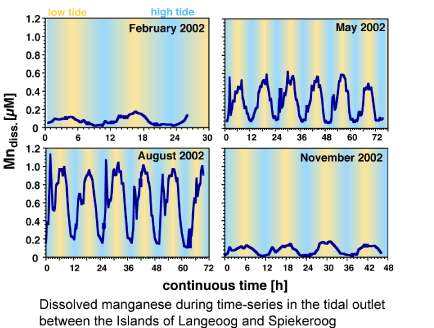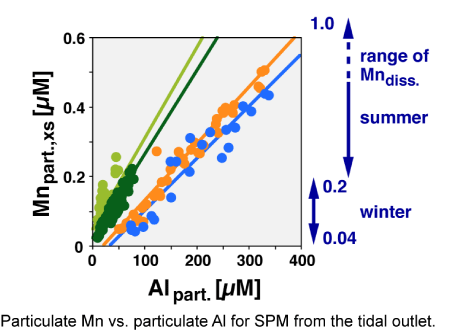
BioGeoChemistry of Tidal Flats
The Wadden Sea: An important manganese source for the North Sea?
The redox-sensitive trace metal Manganese is an essential micronutrient for phytoplankton as it is involved in photosynthesis as well as in an assortment of enzymes and proteins. In addition, the transfer of dissolved Mn to the particulate phase via microbial and photo-oxidation also influences the cycles of other trace metals by scavenging. Concentrations of dissolved Mn observed in the North Sea are found to be up to more than a magnitude higher than those in the North Atlantic, which is generally explained by benthic fluxes from the sediments and by riverine input. However, tidal flats and salt marshes gain importance for the carbon, nutrient, and trace metal budgets of the open oceans. The major aim of our sub-project is to balance the input/output of the dissolved and particulate load between the backbarrier tidal flats and the open North Sea.

Dissolved Mn in the Wadden Sea reveals a clear tidal and seasonal dependence with increasing values towards low tide and summer. Suspended particulate matter from the Wadden Sea is also enriched in Mn, due to the oxidation of dissolved Mn and subsequent adsorption on particles. Excess Mn, which reflects the amount of Mn added to SPM, shows a clear seasonality with increasing contents from winter to summer. Although the Mn content of the individual particles in winter and fall is distinctly lower when compared with the other seasons, the high SPM load leads to considerable particulate Mn concentrations in the water column.

The major Mn sources for the Wadden Sea environment are the pore water, which drains out of the tidal flat sediments during ebb tide, and freshwater from the hinterland. Analyses of pore water and tidal creek water revealed high Mn concentrations in comparison to the open water column. The Mn enrichments tend to increase from winter to summer due to more pronounced microbial activity within the sediments during summer. The freshwater environment of the study area is also rich in Mn as a result of mobilisation from soils and diffusion out of anoxic stream sediments. Depending on water level and rainfall, the freshwater is commonly discharged to the Wadden Sea via the flood-gate in Neuharlingersiel close to low-tide.
Based on variations in salinity we estimated the amount of dissolved Mn added to the backbarrier system. From this simple balance we inferred that during rainy phases in winter and fall the observed Mn concentrations in the Wadden Sea can to a large part be explained by the freshwater contribution, whereas the Mn budget of the Wadden Sea is almost entirely controlled by the pore water input in summer.
Given the importance of establishing the input/output budgets between the intertidal system and the open sea, physical parameters are now monitored by a time-series station in the major tidal outlet of the Spiekeroog backbarrier area. Within the scope of our future work data acqusition at the station will also embrace selected geochemical parameters such as dissolved Mn, methane, and nutrients.
| << back |
Publications
|
|